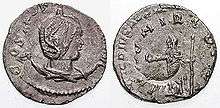Regalianus
| Regalianus | |||||
|---|---|---|---|---|---|
| Usurper of the Roman Empire | |||||
 | |||||
| Reign | c. 260 | ||||
| Predecessor | Gallienus | ||||
| Successor | Gallienus | ||||
| Died |
260 Carnuntum, Pannonia | ||||
| Wife |
| ||||
| |||||
P. C(assius?) Regalianus (died 260) was a Dacian general[3] who turned against the Roman Empire and became himself emperor for a brief period, being murdered by the hands who raised him to power.[3]
Career
The main source of information is the unreliable and for the most part fabricated Historia Augusta. Other sources are Eutropius, who calls him Trebellianus, and Aurelius Victor and the Epitome de Caesaribus, which call him Regillianus. About his origin, the Tyranni Triginta says he was a Dacian, a kinsman of Decebalus.[4] He probably was of senatorial rank, and had received military promotion from the Emperor Valerian.[2]
After the defeat and capture of Valerian in the east (260), the border populations felt insecure, and elected their own emperors to guarantee they would have leaders against the foreign threats.[5] The population and the army of the province of Pannonia had chosen Ingenuus, and elected him emperor, but the lawful emperor, Gallienus, had defeated the usurper.[6]
Gallienus had moved to Italia, however, to deal with an invasion of the Alamanni. The local population, facing the threat of the Sarmatians, elected Regalianus emperor,[7] who raised his wife, Sulpicia Dryantilla, who was of noble lineage, to the rank of Augusta to strengthen his position.[5] Regalianus bravely fought thereafter against the Sarmatians. Short time after his victory, he was killed by a coalition of his own people and of the Roxolani.[5]
A few, probably fictitious,[8] anecdotes survive about this man, in the brief biographical sketch of him given in the Book on Thirty Tyrants in the Historia Augusta: it is stated for example that he was raised to the throne because of his name (Regalianus, "of a king" or "kingly"); when his soldiers heard this jest they greeted Regalianus as their emperor.[9]
Notes
- ↑ All the coinage of Regalianus and Dryantilla is composed of antoniniani struck over other coins, mostly from the reign of Septimius Severus, Alexander Severus and Maximinus Thrax. The only mint to issue coins for Regalianus was the mint of Carnuntum in Pannonia (modern Austria); most of the coins have been found in a small zone around the same city, testifying for a little spread of the rebellion.
- 1 2 Jones, p. 762
- 1 2 Akerman, John Yonge. A descriptive catalogue of rare and unedited Roman coins:from the earliest period of the Roman coinage, to the extinction of the empire under Constantinus Paleologos. p. 80.
- ↑ Historia Augusta, Tyranni Triginta, 10:8
- 1 2 3 Leadbetter, William (1998). "Regalianus (260 A.D.)". De Imperatoribus Romanis.
- ↑ Jones, p. 457
- ↑ Canduci, p. 85
- ↑ Syme, R., Ammianus and the Historia Augusta (1968), p. 168
- ↑ Historia Augusta, Tyranni Triginta, 10:6
See also
References
![]() Media related to Regalianus at Wikimedia Commons
Media related to Regalianus at Wikimedia Commons
- Leadbetter, William (1998). "Regalianus (260 A.D.)". De Imperatoribus Romanis.
- Jones, A.H.M.; Martindale, J.R. (1971), The Prosopography of the Later Roman Empire, Vol. I: AD260-395, Cambridge University Press
- Canduci, Alexander (2010), Triumph & Tragedy: The Rise and Fall of Rome's Immortal Emperors, Pier 9, ISBN 978-1-74196-598-8
- Clinton, Henry Fynes (1850), "Appendix", Fasti Romani: From the death of Augustus to the death of Heraclius